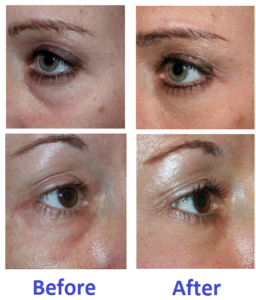Dr. Annunziata is one of the only providers in the Charlotte Metro Area specially trained to perform under eye filler injections.
Dr. Christine Annunziata specializes in facial cosmetic surgery and non-surgical procedures including under eye fillers. To learn more about your options and all of the services she provides, call our office at (704-234-1930) to schedule a consultation.
One of the most commonly requested treatments in my office is for under eye bags. Hollowing under the eyelids and bulging of the eyelid fat can lead to a tired or aged look that can affect a person’s self-esteem, mood, and even how other people relate to them. In the past, surgery was the only option to help reduce the puffy, drooping look of the eyes. Over the last 15 years, new technological advances have made it possible to use injectable wrinkle fillers to fill hollows, lines and wrinkles safely, and at a fraction of the cost of traditional surgery.
Injectable wrinkle fillers work by filling up lines and creases or areas of volume loss with different substances that maintain their shape under the skin to restore youthful volume. Results are instantaneous and last 6 months to a year depending on the treatment location. The most common areas for use are cheeks, mouth, lips, jawlines and chins.
Which filler should you get?
An experienced doctor will be able to pick the right product for your needs. My best advice is to not use price as your guide. Extremely discounted services like Groupon can often be enticing, but If an injector is offering a deal far below the standard pricing for your community, it is likely that some compromise is being made in order to make up for that difference. It may be the skill of the provider or the quality of the product, but either way, you should never take these risks with your face. It isn’t worth it.
There are dozens of different fillers to choose from and not all are appropriate for under eyes. I generally recommend avoiding products that are marketed as permanent, including silicone, acrylic-based, and calcium-based products. They cannot be removed if there is a problem and are not appropriate for the sensitive under eye area.
The most popular category of under eye fillers contain hyaluronic acid. Hyaluronic acid is a substance that naturally occurs in our bodies and functions in shock absorbtion, lubrication, and tissue repair among other things. Because it is naturally occurring, our bodies also have a naturally occurring substance that gradually dissolves the material over time. This rate of absorption determines how long the fillers last, but also allows us to dissolve the material early if necessary. This reversibility helps minimize side effects and reduce risk for patients.
What are the risks of fillers?
Swelling and bruising can occur with all filler injections and in even the most experienced hands. I recommend avoiding blood thinners 1-2 weeks prior to injections as well as a pre and post treatment anti-bruising kit to minimize the risk.
Lumps and bumps can also occur but are minimized with proper technique and product selection. Most visible filler material can be massaged or dissolved away if necessary.
Discoloration called Tyndall effect results in a bluish tint of the filler when it is injected superficially, especially in fair or thin skin. Certain fillers are more likely to cause this effect under the lid and this can be minimized with proper product selection.
Allergy, inflammation, and infection are rare. Wrinkle fillers should be performed by a trained medical professional in a medical setting with sterile instruments. Procedures done in homes, salons, hotels, cruise ships or resorts are not medical settings and carry a higher risk of complications regardless of who is doing them.
Vision loss is the most devastating potential complication of facial fillers. World-wide, there have only been 50 cases ever reported, many of which occurred during injection of fat as a filler and not with hyaluronic acid fillers. Certain areas of injection are associate with higher risk, with the nose being the highest risk area by far. The under eye region is one of the least likely regions to have filler-associated vision loss especially in the hands of an experienced provider.
What is the bottom line?
Use an experience provider. Your doctor should be able to show you before and after photos from previous patients as well as give you evidence of their credentials, training and experience both with fillers in general and in particular with under eye fillers. Providers who have specialized surgical knowledge of the under eye anatomy like oculoplastic surgeons are among the most qualified to perform these procedures with the best results and the lowest risk.
Disclaimer: As an oculoplastic surgeon, I have been injecting fillers under eyes for more than 10 years and this blog is meant to share my professional medical experience with this technique and not to provide specific medical advice to a particular patient. Currently, under eye filler is considered an off-label use by the FDA, so it is important that any patient seeking this treatment find a physician with extensive experience with the under-eye anatomy including use of fillers in the area.




